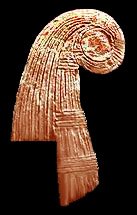|
Inanna
Inanna (Innin, or Innini)
is the Goddess of the Morning and Evening Star. She
is known as "First Daughter of the Moon" Sitting upon Her lapis
lazuli throne, She was the beloved Goddess of Sumeria. Among Her
many other titles, Inanna is the "Goddess of Love and Procreation".
Sacred marriage rites were performed at New Year and the blessings
of Inanna were sought to insure fertility.
Inanna was the
patron and special god/goddess of the ancient Sumerian city of Erech
(Uruk), the City of Gilgamesh. As Queen of heaven, not only was she
associated with the Evening Star (the planet Venus), but sometimes
with the Moon. She may also have been associated the brightest stars
in the heavens, as she is sometimes symbolized by an eight-pointed
star, a seven-pointed star, or a four pointed star. In the earliest
traditions, Inanna was the daughter of An, the Sky, Ki, the Earth
(both of Uruk, (Warka)). In later Sumerian traditions, she is the
daughter of Nanna (Narrar), the Moon God and Ningal, the Moon
Goddess (both of Ur).
The Semites
honoured Inanna as Ishtar. She Presides over the birth of both night
and day. Next to Inanna is the sacred star sign of brilliant Venus.
The Star of Venus is a symbol of both death and rebirth. The winged
Goddess moved freely between the worlds.
Inanna descended into the underworld,
adorned in Lapis Lazuli. She died and in three days returned alive
to walk upon the Earth. The story of Her descent and return are
ancient rebirth stories. Inanna's rising from the dead is a
forerunner of the Christian story of Jesus' resurrection, which
parallels the earlier Inanna journey. The book "Inanna Queen of
Heaven and Earth" by Wolkstein & Kramer recounts this tale in
translations of ancient tablets.
 The
Knot of Inanna is sacred to the Goddess. (See image left) The image
of this knot was the first written form of the Goddess's name. The
Knot of Inanna often appears as the top of a tall pole. This symbol
of the Goddess's authority was probably the original archetype of
the much later crosier, which is carried by Christian bishops and
abbots. The
Knot of Inanna is sacred to the Goddess. (See image left) The image
of this knot was the first written form of the Goddess's name. The
Knot of Inanna often appears as the top of a tall pole. This symbol
of the Goddess's authority was probably the original archetype of
the much later crosier, which is carried by Christian bishops and
abbots.
|